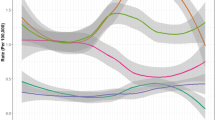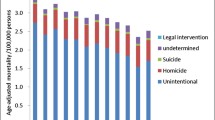Abstract
Our study described demographics and trend analysis in unintentional struck by/struck against fatalities in the United States from 1999 to 2006, and identifies the changes in deaths for specific population subgroups. Mortality data came from the CDC’s Web-based Injury Statistics Query and Reporting System. Trends during 1999–2006 were analyzed by gender, age group and race. Annual percentage change in deaths/rates and log-linear regression was used for time-trend analysis from 1999 to 2006, and examines its significance. During 1999–2006, there were 7,049 deaths; 6,236 (88.5%; 0.56 per 100,000) males, 6,180 (87.7%; 0.32 per 100,000) whites, and 1,925 (27.3%) aged 45–59 years. Overall deaths declined by 4.4% during 1999 to 2006 (P = 0.047 for time-related trend). The proportion of deaths was almost similar among males and females (1.1% vs. 0.3%; P = 0.58), and whites and blacks (0.8% vs. 0.7%; P = 0.44). Almost 21% of all deaths occur in only three states of the US i.e., Texas (n = 592; 0.35 per 100,000), California (n = 513; 0.18) and Florida (n = 375; 0.28). Sub-group analysis showed, injury mortality decreased 5% in males and 1% in females, this change was not statistically significant overtime in both sexes. Prevention efforts for struck by/struck against fatalities should be strengthened and surveillance for these deaths should continue to follow future trends.


Similar content being viewed by others
References
Peden M, McGee K, Krug E. Injury: a leading cause of the global burden of disease, 2000. Geneva: WHO; 2002.
World Health Organization. Injuries, Geneva, World Health Organization; 2009.
World Health Organization. The injury chart book: a graphical overview of the global buden of injuries, Geneva 2002 [cited 2010 September 12]; Available from: http://whqlibdoc.who.int/publications/924156220x.pdf.
Centers for Disease Control and Prevention. National centers for injury prevention and control. Web-based injury statistics query and reporting system (WISQARS). 2005 [cited 2008 February 28]; Available from: www.cdc.gov/ncipc/wisqars.
World Health Organization. International classification of diseases 9th revision. Geneva: WHO; 1977.
World Health Organization. International classification of diseases and related health problems 10th revision. Geneva: WHO; 1992.
Centers for Disease Control and Prevention. Nonfatal occupational injuries, illnesses–United States, 2004. MMWR Morb Mortal Wkly Rep. 2007;56(16):393–7.
United States Bureau of Labor Statistics. Serious injuries befall workers struck by objects. 1997 [cited 2009 December 19]; Available from: http://www.bls.gov/opub/ils/pdf/opbils16.pdf.
Hard DL, Myers JR. Fatal work-related injuries in the agriculture production sector among youth in the United States, 1992–2002. J Agromedicine. 2006;11(2):57–65.
Hoyert DL, Arias E, Smith B, Murphy SL, Kochanek KD. Deaths: final data for 1999. Natl Health Stat Report. 2001;49(8):1–114.
JMP®. Statistical Discovery Software. Cary, NC: SAS Institute Inc; 2010.
World Health Organization. World report on child injury prevention: Geneva. 2008 [cited 2010 September 16]; Available from: http://whqlibdoc.who.int/publications/2008/9789241563574_eng.pdf.
Bulzacchelli MT, Vernick JS, Sorock GS, Webster DW, Lees PS. Circumstances of fatal lockout/tagout-related injuries in manufacturing. Am J Ind Med. 2008;51(10):728–34.
Centers for Disease Control and Prevention. Work-related fatalities associated with tree care operations–United States, 1992–2007. MMWR Morb Mortal Wkly Rep. 2009;58(15):389–93.
The Georgia Tech OSHA Safety and Health Consultation Program. Avoiding struck-by hazards in the construction industry. 2007 [cited 2009 December 15]; Available from: http://www.oshainfo.gatech.edu/techguides.html.
Centers for Disease Control and Prevention. Fatal occupational injuries–United States, 2005. MMWR Morb Mortal Wkly Rep. 2007;56(13):297–301.
United States Bureau of Labor Statistics. Fatal occupational injuries to workers struck by objects by type of object 2006.
Stirbu I, Kunst AE, Bos V, Van Beeck EF. Injury mortality among ethnic minority groups in the Netherlands. J Epidemiol Community Health. 2006;60(3):249–55.
Hayes JR, Groner JI. Minority status and the risk of serious childhood injury and death. J Natl Med Assoc. 2005;97(3):362–9.
Murray LR. Sick and tired of being sick and tired: scientific evidence, methods, and research implications for racial and ethnic disparities in occupational health. Am J Public Health. 2003;93(2):221–6.
Schulte PA, Stephenson CM, Okun AH, Palassis J, Biddle E. Integrating occupational safety and health information into vocational and technical education and other workforce preparation programs. Am J Public Health. 2005;95(3):404–11.
National Institute for Occupational Safety and Health. Fatality Assessment and Control Evaluation (FACE) Program 2009 [cited 2010 January 18]; Available from: http://www.cdc.gov/niosh/face/.
National Institute for Occupational Safety and Health. Traumatic occupational injuries. 2010 [cited 2010 January 18]; Available from: http://www.cdc.gov/niosh/injury/.
Brunette MJ. Development of educational and training materials on safety and health: targeting Hispanic workers in the construction industry. Fam Community Health. 2005;28(3):253–66.
Ringen K, Seegal J, Englund A. Safety and health in the construction industry. Annu Rev Public Health. 1995;16:165–88.
Kircher T, Nelson J, Burdo H. The autopsy as a measure of accuracy of the death certificate. N Engl J Med. 1985;313(20):1263–9.
Conflict of interest
None declared.
Author information
Authors and Affiliations
Corresponding author
Rights and permissions
About this article
Cite this article
Nasrullah, M., Muazzam, S. Unintentional Struck by/Struck Against Injury Mortality in the United States, 1999–2006. J Immigrant Minority Health 13, 948–953 (2011). https://doi.org/10.1007/s10903-010-9420-y
Published:
Issue Date:
DOI: https://doi.org/10.1007/s10903-010-9420-y




